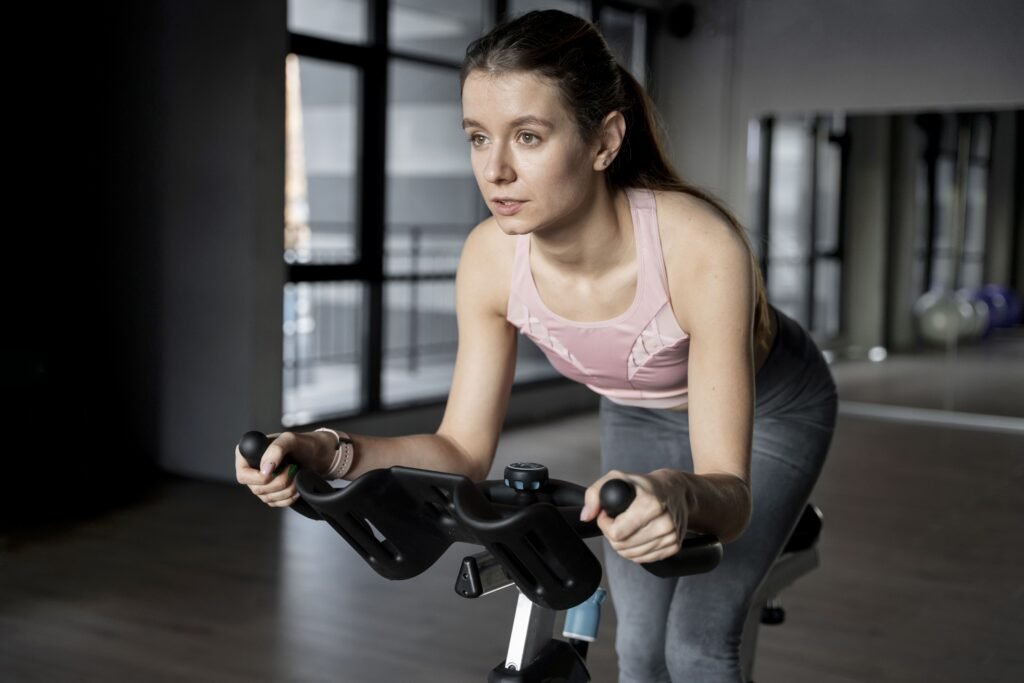The Best Fluffy Pancakes recipe you will fall in love with. Full of tips and tricks to help you make the best pancakes.
Indoor Cycling Mistakes: Top 10 Beginner Blunders Fixed
Learn How Beginner Mistakes in Indoor Cycling Can Stop You From Reaching Your Goal Faster and Improve Your Workout Performance

You clip in. The room’s quiet except for the whir of your trainer. Maybe it’s early morning before work, or maybe you’re squeezing in a ride after a long day. Either way, you feel the pressure to go hard, to make it “count.” We get it. When we first started, we all did indoor cycling mistakes , we thought intensity and sweat meant progress. But the truth? Many of us learned the hard way that effort without structure can lead to burnout, injuries, and stalled gains.
This post is here to change that.
We’ve collected the most common — and easily fixable — indoor cycling mistakes beginners make, so you can fast-track your progress and stay consistent. Whether you’re just starting out or finally getting serious about your indoor training, these tips will save you time, energy, and frustration. You don’t have to learn the hard way like we did — let’s get smarter, together.
Going Too Hard, Too Often
Many newcomers to indoor cycling treat every session like a high-intensity race or spin class. This approach leads to rapid burnout, overtraining symptoms, and stalled fitness gains. Your body needs a mix of intensities to build a strong aerobic base, and recovery rides are just as important as hard efforts. The key is earning your high-intensity intervals through consistent base building. Follow structured training with purposeful intensity distribution rather than going all-out every time you clip in.
Want to build intensity the right way? Check out our structured guide: Indoor Cycling Training for Busy Cyclists.
Inadequate Cooling Setup
One of the most overlooked indoor training mistakes involves proper ventilation. Beginners often assume a cracked window or small desk fan provides sufficient cooling, but indoor environments trap heat far more than outdoor riding. Without adequate airflow, you’ll overheat quickly, leading to decreased performance and compromised recovery. Invest in at least two powerful fans positioned strategically – one facing your chest and another targeting your side or legs. This creates the cross-ventilation needed for effective heat management.
Poor Hydration Strategies
Hydration mistakes rank high among beginner cycling mistakes that impact performance immediately. Some riders forget to drink entirely, while others rely solely on water during longer or intense sessions. Dehydration crushes power output, mental focus, and post-workout recovery. For effective hydration, drink small amounts every 10-15 minutes throughout your ride. Sessions lasting over 45 minutes require electrolyte replacement to maintain optimal performance levels.
Ignoring Proper Bike Fit
Indoor cycling for beginners becomes painful quickly when bike fit issues go unaddressed. Incorrect saddle height, improper reach, or poor cleat positioning leads to knee pain, back discomfort, saddle sores, and inefficient pedaling. Unlike outdoor riding where terrain changes provide natural position shifts, indoor training exposes every fitting flaw. Take time to learn basic fit principles and make incremental adjustments until you find a comfortable, efficient position.
Curious how to avoid these early discomforts? Our full post on Best Indoor Cycling Tips for Beginners walks you through the essentials.
Skipping Indoor Cycling Warm-Up and Cool-Down Mistakes
Jumping directly into intervals or stopping abruptly after hard efforts represents a critical oversight in indoor training tips. This approach increases injury risk and slows your performance progression over time. Always begin with a 10-15 minute gradual warm-up to prepare your cardiovascular system and muscles for work. Similarly, spend 5-10 minutes cooling down with easy spinning to help your body transition back to rest.
Lack of Training Structure
Random rides without progression plan represents one of the most limiting beginner cycling mistakes. Without systematic overload, your fitness plateaus quickly, and chaotic training often leads to burnout. Implement a progressive training structure that alternates between hard and easy days. At minimum, follow the basic principle of building intensity gradually while maintaining consistent easy days for recovery.
Poor Cadence Control
Many beginners develop inefficient pedaling habits, either grinding at low cadences or spinning too fast without control. Both extremes waste energy, stress joints unnecessarily, and compromise pedaling technique. Target a cadence range of 85-95 RPM for most training situations. Learning to control your cadence, especially during interval work, improves efficiency and reduces fatigue accumulation.
Insufficient Recovery Planning
The “more equals better” mentality drives many beginners to avoid cycling mistakes by training daily without rest periods. However, fitness adaptations occur during recovery, not during the actual workout. Schedule 1-2 complete rest days weekly, or use very easy Zone 1-2 active recovery rides when needed. Your body needs time to adapt to training stress and rebuild stronger.
Over-Reliance on Entertainment-Based Workouts
While music-driven classes and virtual rides provide entertainment value, relying exclusively on these formats limits long-term development. Entertainment-focused sessions often lack progression principles, training specificity, and meaningful performance data. Balance fun rides with structured sessions that target specific fitness adaptations like threshold power, endurance capacity, or neuromuscular development.
Neglecting Mental and Physical Setup
Your training environment significantly impacts motivation and consistency. A cluttered, poorly lit, or uncomfortable space creates mental barriers that lead to skipped sessions. Create an inspiring training area with adequate lighting, organized equipment storage, and motivational elements like goal tracking or inspiring imagery. Having water, towels, and other essentials easily accessible removes friction from your training routine.
Avoid These Beginner Mistakes and Build a Strong Indoor Cycling Foundation
Indoor cycling is one of the most efficient ways to improve your fitness — especially when time and flexibility matter. But beginners often fall into the same traps: training too hard too often, skipping recovery, ignoring bike fit, and relying solely on entertainment-based workouts without any structure.
To truly progress, you need a balanced approach that includes structured training plans, proper cadence control, smart hydration, and an optimized training environment. Overtraining without purpose leads to burnout, and overlooking cooling or hydration severely impacts performance. Simple fixes — like placing two powerful fans, drinking electrolytes during longer sessions, or adjusting saddle height — can drastically improve your comfort and efficiency.
Don’t underestimate the power of warm-ups, rest days, and cadence awareness. And while fun rides are great for motivation, structured sessions are what deliver lasting gains.
Remember, recovery is where your body actually gets stronger — not during the ride. Schedule rest days, track your progress, and dial in your environment to make training something you want to do. If you’re looking for indoor cycling tips that fit into a busy schedule, check out our post: Indoor Cycling Training for Busy Cyclists.
And for a deeper dive into beginner fundamentals, don’t miss: Best Indoor Cycling Tips for Beginners.
and always remember :
The guidance we once needed — now shared with you.






[…] more guidance on avoiding common training pitfalls, check out our comprehensive guide on indoor cycling mistakes that can derail your progress. Smart preparation and proper technique will keep you pedaling strong […]
[…] can check other posts also to learn How to Plan your Training and some tips , or even Avoid some Mistakes! And always remember […]